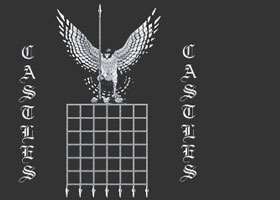Caernarvon Castle & the Historia Regum Britanniae!
Caernarvon was a key position for one of the Medieval Welsh Castles of King Edward. Caernarvon was a very ancient Welsh town. The Druid Wizard, Merlin, and several prophecies, were strongly associated with Caernarvon! Merlin was believed to have been born in a cave outside Caernarvon. The name Caernarvon is believed to be derived from 'Caer Myrddin' meaning Merlin's town or fortress. Merlin was closely linked with King Arthur and was also linked with the transportation of the great Stonehenge stones! The connection between Caernarvon, King Arthur, Merlin, Prophecies and even great stones had been made. Caernarfon was also strongly associated with the might of imperial Rome. The building of the new Castle at Caernarvon could be used to to emphasise these connections in a highly visual fashion! The Prophecy of Merlin!
The Prophecy of Merlin was detailed in the Historia Regum Britanniae. Prophecies, by nature, are ambiguous and can be interpreted in many ways. The Prophecy of Merlin indicated that a a descendant of Cadwallader would rise to power and begin the "slaughter of foreigners". Cadwallader was a legendary Welsh king and a leader of the Celtic resistance against the Anglo-Saxons. Welsh myths and traditions say he was the last Welsh king to wear the crown of Britain. Cadwallader has been identified as King Arthur. The Welsh Royal house of Gwynedd claimed to be the direct descendants of Cadwallader. It was therefore imperative that King Edward eradicated all the members of the Royal House of Gwynedd - of which his Welsh adversary, Llywelyn ap Gruffyd, was the leader. And it would also be very helpful if Edward's Royal House of Plantegenet could somehow step into the shoes of the Welsh Royal House! This idea stayed firm in the mind of King Edward. The great castle at Caernarvon was built. Edward's son was born at Caernarvon Castle ( which was only half built at this time). Edward's son, who became King Edward II, was given the title of the ' Prince of Wales'. King Edward I had produced a Welsh born Prince of Wales. Another prophecy of Merlin contains the story that the red dragon symbolises Britain and the white dragon symbolises the Saxons. Merlin also predicted, that in time, the white dragon (the Saxons) would overcome the red dragon. Merlin also foretold that six descendants of King Arthur would rule after the great king before Saxons would return and conquer Britain. Caernarvon Castle & more Welsh Myths and Legends!
The Prophecies of Merlin helped with King Edward I credibility. This was enhanced still further by the interpretation of additional legends - also described in the Historia Regum Britanniae by Geoffrey of Monmouth. This story surrounded Magnus Maximus, Prince Macsen, the Macsen Wledig of Welsh legend who was one of the greatest figures in Britain towards the end of the Roman Empire. General Magnus Clemens Maximus was a Celt. He was the uncle of the Welsh King, Coel Godhebog "the Magnificent" (Old King Cole of the Nursery Rhyme) by marriage. Coel Godhebog's daughter married Emperor Constantius Chlorus. The capital of the Roman Empire transferred from Rome to Constantinople in 330AD. We now have a connection between the Imperial Roman Emperors, the great city of Constantine and the Welsh Royal family. The base of Magnus Maximus, the Macsen Wledig of Welsh legend was Carmarthen. In the Historia Regum Britanniae by Geoffrey of Monmouth the legend surrounding a dream of Magnus Maximus is described. In this dream saw "a great city with towers of many colours and eagles fashioned out of gold". Enter the Medieval 'Spin Doctors' again! The Caernarvon Castle & Welsh Mythology
It is no coincidence that Caernarvon Castle was built differently to the other Welsh castles! The master builder and architect Master James of St George would have been very aware of these myths and legends and prophecies of Merlin. And he designed Caernarvon Castle accordingly! The walls of the Caernarvon Castle were given a striking patterning with bands of different coloured stone - an allusion to the "towers of many colours". The towers were of an angular design as opposed to the round towers of other castles reflecting the architecture of Constantinople. The turrets of Caernarvon Castle are surmounted by eagles "eagles fashioned out of gold". One of the towers of Caernarvon Castle is named the 'Eagle Tower'. The 120 feet high Eagle Tower, which contained the Royal Suite, was surmounted with three turrets , each turret was adorned by an eagle. The design and architecture of Caernarvon Castle is steeped in Welsh mythology. Caernarvon castle was built to embody both history and legend. | 
